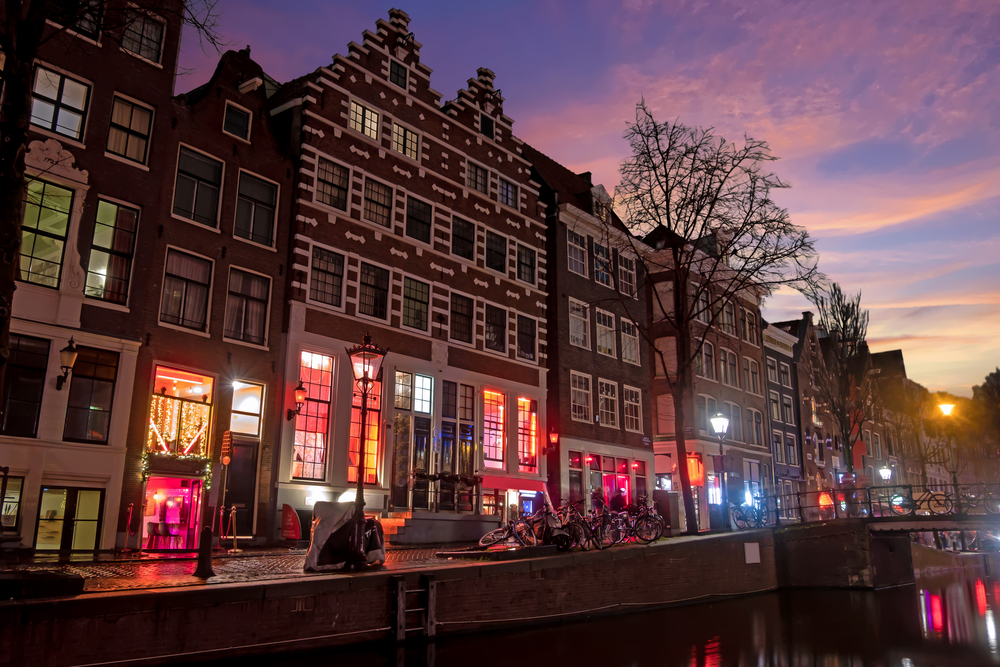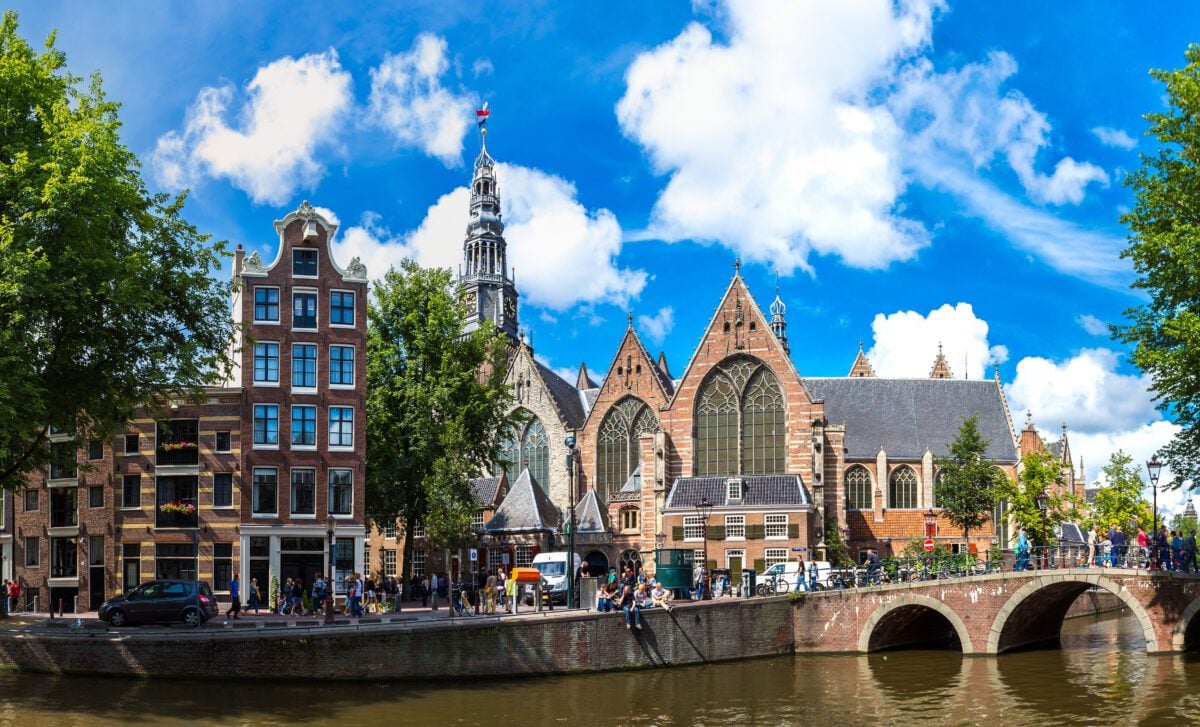Amsterdam’s Red Light District is one of the most famous neighbourhoods in the world — but there’s even more to it than it seems.
Today, the neighbourhood is packed with tourists who walk around with awe and fascination daily. They want to know: do the women really just stand there naked? Can you just walk in? Who are these women behind the windows?
The Red Light District has a rich history, dating back to the 13th century. And boy, is it an interesting one, from the deliberate choice of lighting, the convenient location leading to its fame, to the centuries-old tug of war to legalise sex work.
READ MORE | How to see the Red Light District in Amsterdam [2024 Guide]
Get ready as we dive into its history of STDs, sailors, and, best of all, sin.
Red Light District: What’s in a name?
The term “red light district” isn’t just used for the famous area in Amsterdam. Any place with prostitutes is considered a red light district, regardless of the country or legality.
The name of the main neighbourhood where Amsterdam’s red light district is located is actually de Wallen.

So, there are more red-light districts than the famous one in Amsterdam. But why did this one become the Red Light District, capital letters and everything?
Well, that was a combination of two things: first, Amsterdam was a major trading port because it was so close to the harbour. This also made it easier for sailors (the ones who were doing the trading) to get into the city and enjoy its… entertainment.
Second, the city was relatively laid back regarding prostitution in general. In fact, it was legal until the 16th century, then illegal, then legal, and so on (but we’ll get to that later).
So the accessible location and the relatively open-minded attitude towards prostitution was the perfect combination to make Amsterdam’s Red Light District so famous — and earn it the capital letters.
The back and forth of legalising prostitution in Amsterdam
Cast your mind back to 1270, a time so long ago that it doesn’t even sound like a real year. Despite Amsterdam’s then-tiny size, its popularity as a trading port meant there were plenty of sailors, all of whom had needs.
At the time, prostitution was tolerated in the Netherlands. By this, we mean that sex workers weren’t punished for their profession but weren’t particularly respected either.
Regardless, the concept of “honour” was very important in the Middle Ages; sex workers were seen as “dishonourable” and deprived of some rights, such as marriage.

To shelter their precious society from these dishonourable women, city governments in the Netherlands restricted sex work to certain areas — one of which was de Wallen in Amsterdam.
READ MORE | Sex work is work: etiquette and a guide to Amsterdam’s Red Light District
But in the 16th century, with the Spanish occupation and the rise of Protestantism (a branch of Christianity), everyone got more uptight. Church and state blended, and anything “sinful” was also illegal.
Brothels were in Amsterdam’s Red Light District before you were born. #Amsterdam, 1905. Prostitutes in front a brothel: #til #history pic.twitter.com/3yIXemcWXy
— Amsterdam Red Light District (@AmsterdamRLDT) March 26, 2023
By the turn of the 18th century, everything was quite strict and in line with the morals preached by the church. On top of this, there was a growing middle class that wanted to avoid being associated with the lower class — which included sex workers.
The middle class did so by not only restraining from sex (it was seen as sinful) but also by moving to different neighbourhoods to distance themselves physically from these “loose” people.
Although prostitution was still decriminalised at the time, the working conditions of prostitutes were very poor. They had no proper birth control, condoms, or cures for STIs. The workers were neglected and looked down upon.
Then came Napoleon and his army. He was not the nicest guy, but his approach to prostitution was more progressive than in many first-world countries today.
Under his rule, sex workers reported twice weekly to the police for a medical checkup. If they were sick, they received free treatments and stopped working until they recovered.
But before you go rewarding Napoleon for his open-mindedness, he wasn’t doing this out of respect for women. This health regulation was done in order to protect soldiers from diseases.

After Napoleon’s occupation, the Netherlands became Christian again and — you guessed it — less tolerant of sexual openness.
Religious representatives would actively try to change attitudes about prostitution by reciting the Bible and singing religious songs to sex workers and clients.
Because of this, it became illegal for sex workers to stand in doorways to seduce men. However, they could still solicit men through their windows — leading to the start of window prostitution as we know it today.
And finally, finally, sex work was decriminalised in the second half of the 20th century. In 1999, prostitution in the Netherlands was defined as a legal profession by the Dutch government.
What a whirlwind. 😮💨
Amsterdam: Europe’s rebellious child
As we’ve established, Amsterdam doesn’t have the world’s most innocent reputation. For instance, it was known as the City of Sin as early as the 1900s, and priests and married men weren’t allowed in the Red Light District for fear of being corrupted.
Of course, it didn’t help that the lights in the Red Light District were red to hide symptoms of STIs or that the Oude Kerk was built there so sailors could repent for their freshly-committed sins.
the red lights district is like a haunted house for gay men
— harrison 🦫 (@harrisondubay) June 13, 2023
This cemented Amsterdam’s reputation as a party city, brimming with temptation and sin. Everything you weren’t meant to do could be found in this city — especially in the neighbourhood of de Wallen.
This reputation lives on today; just look at the mass of tourists and the global fascination with the neighbourhood. It is cemented into the city, inseparable from the start, from the centuries of controversy until today.
Amsterdam’s Red Light District today
Of course, such a strong and polarising reputation doesn’t die so easily. It has survived attempts to restrict or ban prostitution for centuries.
The attempts weren’t limited to the Middle Ages. In 2007, the municipality of Amsterdam funded a project to restrict prostitution in Amsterdam to a limited number of streets — much like when society was meant to be protected from “dishonourable” women.
Naturally, De Wallen was one of the streets where prostitution would be allowed. Meanwhile, 126 other windows operating around the city were closed as a result of this project.
Amsterdam, Red Light District.
— Amsterdam Red Light District (@AmsterdamRLDT) December 19, 2019
Year 1913 & Now.
(click on the pic to enlarge)#ThrowbackThursday #Netherlands #DeWallen #TBT pic.twitter.com/mwwk4NrLyV
The 2007 project was one of the many attempts to limit prostitution in Amsterdam. Recently, there have been more pushes to move Amsterdam’s Red Light District to a different area or to end the district altogether.
READ MORE | A Sexscraper? Here are Amsterdam’s plans for a new Red Light District
But people have been fighting it. More recently, there have been several protests in Amsterdam against moving the Red Light District to somewhere else.
“We don’t want to be moved, not to an erotic centre or anywhere else. We want to do something about the problems in the area,” a sex worker at a protest told the NOS. “Moving us is not a solution.”
READ MORE | Myths about Dutch history and the truth behind them
So where do we go from here? These talks about moving sex workers or restricting prostitution have been happening for centuries. Today, the debates continue, ranging from restricting the sex workers themselves or the tourists.
Here’s a hot take: maybe sex workers are just normal people who should be allowed wherever they want? Something to think about.
What is your favourite historical fact or part of de Wallen? Tell us in the comments below!





